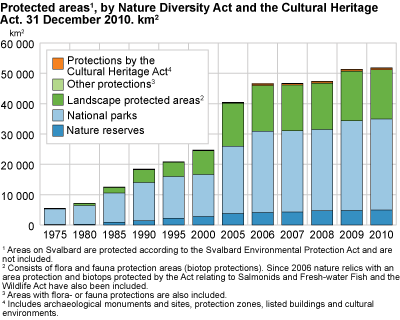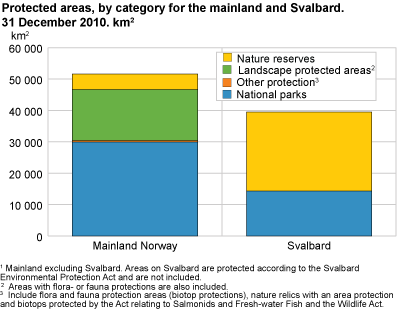Content
Published:
This is an archived release.
Over 9 000 new cultural heritage objects in 2010
During the year 2010, one national park, 99 nature reserves, 8 829 archaeological monuments and sites, 166 listed buildings and 55 security zones have been protected. The total amount of protected areas in Norway exceeded 88 000, broken down into 86 700 on the mainland and 1 200 on Svalbard.
Protected areas on the mainland made up 16 per cent, and on Svalbard as much as 65 per cent of the land area. In total, over 91 300 km2 is protected. In Norway, the national parks combined account for the largest part of the protected areas. The national parks areas are more than 44 400 km2, divided into about 30 000 km2 on the mainland and 14 400 km2 on Svalbard. Norway has a total of 40 national parks, 33 of which are located on the mainland and 7 on Svalbard.
Svalbard has the largest national park
It is on Svalbard we find Norway’s largest national park; South Spitsbergen, with an area of 4 957 km2. The smallest national park on Svalbard, which is almost 70 times larger than the smallest on the mainland, is Indre Wijdefjorden, at 613 km2. However, the national parks on Svalbard only account for 36 per cent of the total conservation area, since it is nature reserves that dominate on Svalbard. The national parks on Svalbard are mainly located on Spitsbergen and Prins Karls Forland.
On the mainland, it is Hardangervidda with an area of about 3 445 km2, which is the largest national park. The smallest national park is Ormtjernkampen, at less than 9 km2. As in Norway as a whole, the area of national parks on the mainland is the largest category of conservation area. In 2010, the national parks made up 58 per cent of the land area, and have increased by approximately 400 km2 during the year. With regard to counties, Oppland and Nordland have the largest amount of protected area of national parks, with approximately 5 000 km2 each. Not all counties have national parks.
Nature reserves area is important as category of conservation
The most frequently occurring category of conservation form is nature reserves on Svalbard, and these also make up the largest conservation area (41 per cent of the group of islands). The group of islands has a total of 25 200 km2 of nature reserves; approximately the same size of area as the national parks on the mainland. The largest nature reserve on Svalbard is Bjørnøya, at 177 km2. The smallest nature reserve is the bird sanctuary Guissezholmen, which is less than 1 km2. There are 21 nature reserves on Svalbard, but more than 2 000 on the mainland. However, on the mainland the nature reserves do not cover as large areas as in Svalbard. Hedmark county has the largest area of nature reserves, and the rest are fairly evenly spread between the remainder of the counties.
Landscape protected areas in all the counties on the mainland
Landscape protected areas, with almost 16 300 km2, make up an important part of the total area of conservation areas on the mainland (32 per cent). All the counties have landscaped protected areas. Møre og Romsdalen has clearly the largest area, with more then 2 600 km2. Oppland has most of them, with a total of 23 landscape protected areas. Svalbard has non-landscape protected areas.
In the category of other protections there is close to 500, but these make up the smallest area of protected areas in Norway, and cover just 1 per cent of the area of Norway. Svalbard has only one conservation area of other protection - a protected geotop area that is located on the west coast of Spitsbergen.
| Mainland1 | Svalbard | The Kingdom of Norway2 | |||||||||||||||||||||||||||||||||||||||||||||||||||||||||||||||||||||||||||||
|---|---|---|---|---|---|---|---|---|---|---|---|---|---|---|---|---|---|---|---|---|---|---|---|---|---|---|---|---|---|---|---|---|---|---|---|---|---|---|---|---|---|---|---|---|---|---|---|---|---|---|---|---|---|---|---|---|---|---|---|---|---|---|---|---|---|---|---|---|---|---|---|---|---|---|---|---|---|---|---|
| Number of protected areas | Area (including freshwater), km2 | Share of mainland Norway, per cent | Number of protected areas | Area (including freshwater), km2 | Share of Svalbard, per cent | Number of protected areas | Area (including freshwater), km2 | Share of mainland Norway and Svalbard, per cent | |||||||||||||||||||||||||||||||||||||||||||||||||||||||||||||||||||||||
| Total | 2 712 | 51 634 | 15.9 | 29 | 39 481 | 64.7 | 2 741 | 91 115 | 23.7 | ||||||||||||||||||||||||||||||||||||||||||||||||||||||||||||||||||||||
| National parks | 33 | 29 960 | 9.3 | 7 | 14 359 | 23.5 | 40 | 44 319 | 11.5 | ||||||||||||||||||||||||||||||||||||||||||||||||||||||||||||||||||||||
| Landscape protected areas3 | 195 | 16 288 | 5.0 | . | . | . | 195 | 16 288 | 4.2 | ||||||||||||||||||||||||||||||||||||||||||||||||||||||||||||||||||||||
| Nature reserves | 2 010 | 4 958 | 1.5 | 21 | 25 109 | 41.1 | 2 031 | 30 066 | 7.8 | ||||||||||||||||||||||||||||||||||||||||||||||||||||||||||||||||||||||
| Other protections4 | 474 | 427 | 0.1 | 1 | 14 | 0.0 | 475 | 441 | 0.1 | ||||||||||||||||||||||||||||||||||||||||||||||||||||||||||||||||||||||
| 1 | Mainland of Norway including islands, but excluding Svalbard. |
| 2 | The Kingdom of Norway consist of the landarea including islands, Svalbard and freshwater. |
| 3 | Areas with flora or fauna protections are also included. |
| 4 | Includes flora and fauna protection areas (biotop protections), nature relics with an area protection and biotops protected by the Act relating to Salmonids and Freshwater Fish and the Wildlife Act. |
Few registered cultural heritage objects on Svalbard
The amount of conservation areas in total is more than 85 000 for the mainland and Svalbard together. Of these, Svalbard has only 1 240 cultural heritage objects. Among the counties on the mainland, only Oslo has fewer cultural heritage objects.
The highest number of new cultural heritage objects that were registered in 2010 was consequently established on the mainland, where archaeological monuments and sites make up the majority, followed by listed buildings and security zones.
Svalbard does not have security zones or cultural environments, but neither do all counties on the mainland have cultural environments.
Hedmark with highest amount of archaeological cultural heritage objects
Archaeological monuments and sites are the dominating category within the cultural heritage form both in number and area. This is the situation on the mainland as well as on Svalbard. Archaeological monuments and sites make up 98 per cent of the total amount of cultural heritage. This is reflected in the distribution of archaeological monuments and sites on the mainland and Svalbard, where they make up 90 and 80 per cent respectively. On Svalbard, most of them are located along the cost, while for the mainland it is the inland county Hedmark that has highest amount of registered archaeological monuments and sites.
Oppland with highest amount of listed buildings
Listed buildings make up the remaining 20 per cent of cultural heritage objects on Svalbard. On the mainland, Oppland has most listed buildings. If we compare the amount of listed buildings on Svalbard with the counties (including Svalbard), Svalbard is slightly below average, with 239 listed buildings compared with the average of 304.
| The mainland1 | Svalbard | The Kingdom of Norway2 | |||||||||||||||||||||||||||||||||||||||||||||||||||||||||||||||||||||||||||||
|---|---|---|---|---|---|---|---|---|---|---|---|---|---|---|---|---|---|---|---|---|---|---|---|---|---|---|---|---|---|---|---|---|---|---|---|---|---|---|---|---|---|---|---|---|---|---|---|---|---|---|---|---|---|---|---|---|---|---|---|---|---|---|---|---|---|---|---|---|---|---|---|---|---|---|---|---|---|---|---|
| Number of protected areas | Area (including freshwater), km2 | Share of the mainland per cent | Number of protected areas | Area (including freshwater), km2 | Share of Svalbard per cent | Number of protected areas | Area (including freshwater), km2 | Share of Norway, per cent | |||||||||||||||||||||||||||||||||||||||||||||||||||||||||||||||||||||||
| Total | 84 048 | 227.2 | 0.1 | 1 240 | 0.2 | 0.0 | 85 288 | 227.5 | 0.1 | ||||||||||||||||||||||||||||||||||||||||||||||||||||||||||||||||||||||
| Listed buildings | 5 842 | 0.9 | 0.0 | 239 | 0.0 | 0.0 | 6 081 | 0.9 | 0.0 | ||||||||||||||||||||||||||||||||||||||||||||||||||||||||||||||||||||||
| Cultural environments | 9 | 53.0 | 0.0 | .. | .. | .. | 9 | 53.0 | 0.0 | ||||||||||||||||||||||||||||||||||||||||||||||||||||||||||||||||||||||
| Archaeological monuments and sites | 77 835 | 152.8 | 0.0 | 1 001 | 0.2 | 0.0 | 78 836 | 153.0 | 0.0 | ||||||||||||||||||||||||||||||||||||||||||||||||||||||||||||||||||||||
| Protection zones | 362 | 20.6 | 0.0 | .. | .. | .. | 362 | 20.6 | 0.0 | ||||||||||||||||||||||||||||||||||||||||||||||||||||||||||||||||||||||
| 1 | Mainland of Norway including islands, but excluding Svalbard. |
| 2 | The Kingdom of Norway consist of the landarea including islands, Svalbard and freshwater. |
Contact
-
Svein Johan Reid
E-mail: sjr@ssb.no
tel.: (+47) 41 51 29 66
-
Jørn Kristian Undelstvedt
E-mail: jorn.kristian.undelstvedt@ssb.no
tel.: (+47) 94 50 68 64


